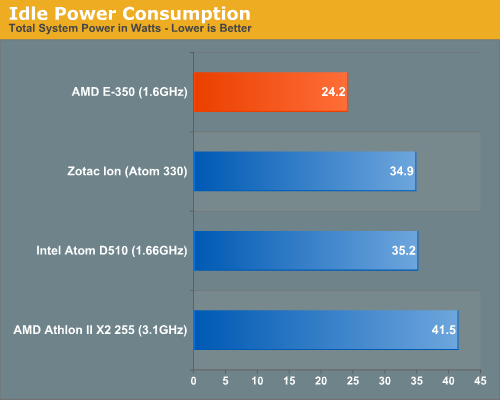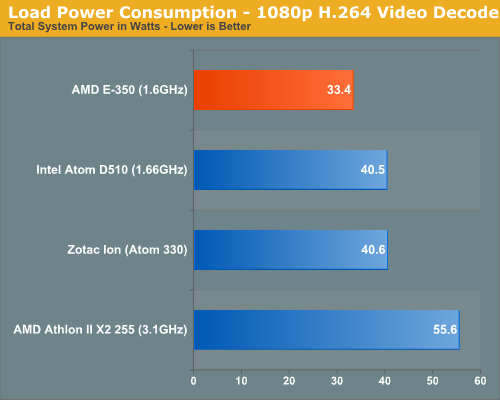The Brazos Review: AMD's E-350 Supplants ION for mini-ITX
by Anand Lal Shimpi on January 27, 2011 6:08 PM ESTPower Consumption: Better than Atom
Power efficiency was a big draw of Atom, but does AMD sacrifice any of that in order to deliver the performance it does with the E-350? To be blunt: no, not at all.
I don’t have any pico PSUs or anything super efficient readily available so don’t expect any of the numbers to be particularly impressive, but what they are is comparable to one another. I hooked up each one of the systems I’d been using to the same PSU and measured power in three conditions: idle, full CPU load (Cinebench 11.5) and while playing a 1080p H.264 video.

Pine Trail and the old ION platform consume just about the same amount of power at idle. The Athlon II system obviously draws more, in this case an increase of 17%. The E-350 uses less than 70% of the power of the Atom D510 system at idle.

Under load the Brazos advantage shrinks a bit but it’s still much lower power than Atom. While playing a H.264 you’re looking at ~83% of the power of an ION system, and 85% under full CPU load.

Say what you will about Intel’s manufacturing process advantage, it’s simply not put to use here with Atom. AMD’s E-350 is higher performing and uses less power than Intel’s 45nm Atom D510. Did I mention it’s built on a smaller die as well?
I wanted to isolate the CP...err APU and look at its power draw exclusively. I ran the same three tests but this time I’m not measuring power at the wall, but rather just power over the ATX12V connector directly to the CPU.
At idle the E-350 APU only requires around 3W of power. That’s actually not as low as I’d expect, especially given that Sandy Bridge is typically down at 4W when fully idle. AMD is apparently not being too aggressive with stopping clocks and gating when fully idle, at least on the desktop Brazos parts.
| Power Consumption Comparison | |||||
| ATX12V Power Draw | Idle | 1080p H.264 Decode | Cinebench 11.5 | ||
| AMD E-350 | 3W | 8W | 9W | ||
| AMD Athlon II X2 255 | 7W | 12W | 47W | ||
Under load, either full CPU or when using the video decode engine, APU power consumption is around 8 - 9W. By comparison, an Athlon II X2 255 will use 12W when decoding video (this doesn’t include the UVD engine in the 890GX doing most of the heavy lifting. The more interesting comparison is what happens when the CPU cores are fully loaded. The E-350 uses 9W running Cinebench 11.5 compared to 47W by the Athlon II X2.










176 Comments
View All Comments
rpsgc - Thursday, January 27, 2011 - link
It will run at x4 (comparable to PCI-E 1.1 x8)rpsgc - Thursday, January 27, 2011 - link
Since I can't edit my post...... look here for the performance penalty of running at x4 versus x16
http://www.techpowerup.com/reviews/AMD/HD_5870_PCI...
codedivine - Thursday, January 27, 2011 - link
Thanks!codedivine - Thursday, January 27, 2011 - link
I was wondering if it is possible to overclock this mobo+APU combo?allzhat - Thursday, March 15, 2012 - link
I use K10stat to increase the multiplier for my notebook (e350) from x16 to x18 (1800Mhz)or even x22 (2200Mhz), but I can't feel more performance for this APU but it draw more power consumption and heat of courseI suggest to use gamebooster for heavy application
PS: I'm sorry for my bad english
nitrousoxide - Thursday, January 27, 2011 - link
So an SSD really makes difference on Brazos platform? Now I can place my order :)My choice is Corsair Nova 64GB since it is the cheapest drive with the minimum accpetable space I need. Any drive cheaper than this one is not big enough and bigger ones are more expensive... Hope its low Random Read performance doesn't impact much, at least faster than an HDD!
Dark_Archonis - Friday, January 28, 2011 - link
Being cheap with SSDs? Good luck when you suffer reliability problems with your SSD.nitrousoxide - Friday, January 28, 2011 - link
Guess what? Somebody ran an durability test for an Intel X-25V, a non-stop read--write-erase cycle for 300 days and still working. Performance began to drop after 6 months, but keep in mind that this stress test is over 20 times beyond daily use. So it actually takes years to destroy an SSD, without SF controller, of course :)mariush - Sunday, January 30, 2011 - link
A sample of ONE is by no means enough. The same person could have tested a second SSD and have it die on him after a week.After all that's what MTBF is all about - the average time for a failure in a population of identical devices.
Ethaniel - Thursday, January 27, 2011 - link
Is it me or the Nano X2 just beats the crap out of both Brazos and Atom? Can we get a review of that chip, Anand?